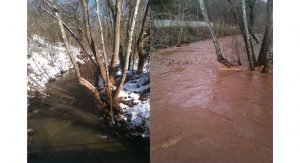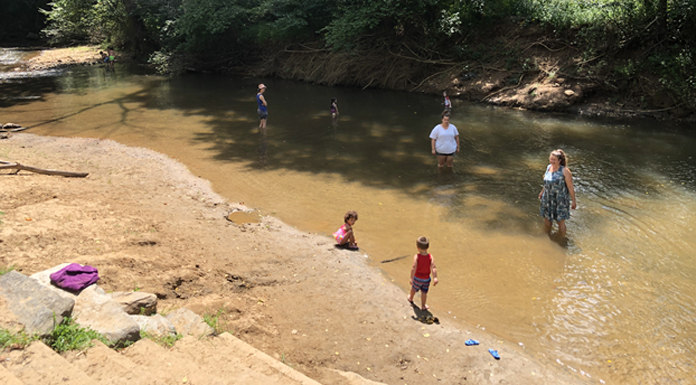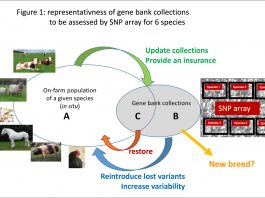Professor Thomas D Shahady from the University of Lynchburg describes the growing concerns over the safety of our freshwater supplies.
A question often asked around the world is: is my water is safe? Whether it is the water flowing into a household, through a stream or lake where people swim, or water used for livestock and pets, we all have this common concern. In this article, I describe the growing concerns over the safety of our freshwater supplies.
Water is the universal solvent. It readily dissolves solutes from surrounding geology often transporting them long distances. Water in your area reflects surrounding conditions and how well or poorly your community is developed. Dissolved nutrients, waste, toxins, plastics, or large woody debris flow daily from our built communities into adjacent neighbourhoods then eventually into our oceans. Dissolved elements influence water chemistry, determining how safe the water may be to drink or swim in. Larger debris such as sediment, plastics, leaves, or tree trunks journey alongside these chemicals, slowly depositing along the way until moved by the next storm event. Chemicals in the water create immediate water quality concerns, while larger debris generates longer-term pollution problems. Nutrients and waste cause bacterial and protozoan growth, while sediment and plastics degrade the habitat and critically impact aquatic life. These problems continue to grow as we develop our watersheds and generate our waste. They threaten the very quality of life and future availability of good freshwater.

Waste
Waste is now an overwhelming problem threatening all sources of freshwater. By tracking the contamination of water using E. coli, nutrients, and electrical conductivity, research can predict how widespread this problem really is. My work in central Virginia, USA, suggests such problems are growing and becoming untenable to control. Comparing three differing land use areas along the same river demonstrates the problem clearly, along with the difficulty in developing any viable solution for clean-up (see Table 1).
A local park where people often congregate to swim is contaminated with enough E. coli to be in violation of state standards for recreation. Here is the problem: upstream is minimally developed but contains enough contamination to be problematic. What can be controlled? To further understand this problem, molecular source tracking was used to pinpoint the exact nature of the contamination. While much of the problem stems from wildlife such as deer, human sources are also present. No identified sources of human input are located above this park, but yet it persists. While the human contribution is low, these numbers suggest enough active bacteria are in the water to create a risk for those who choose to use these waters for recreation. The problem worsens near urban centres. Greater concentrations of E. coli flow from these areas. Exiting a city while flowing back into agricultural areas, bacterial contaminations subside but contributions from human sources continue to occur. We cannot avoid human contamination throughout this river basin.
And then there is storm events. It is well understood that stormwater increases the concentration of E. coli in water dramatically. This trend is consistent throughout all my studies of water quality. So, while concentrations of E. coli increase from stormwater, percent contributions from humans remains constant away from urban areas. These disturbing trends occur in urban areas where human-contributed contamination increases dramatically when it rains. This suggests these areas are poorly designed to properly treat waste to protect our water supplies. Any contact with these waters should be avoided.
Therefore, consider where you are located when thinking of water cleanliness before you drink or swim etc. While contamination is ubiquitous throughout all streams in a landscape, urban development exacerbates this problem. Water at low stage flow contains proportionally less harmful pathogens suggested by low concentrations of E. coli, it still presents a risk and does contain wastes of human origin. Any exposure to human waste risks disease or other health complications. More concerning is the fact that as rivers approach urban or concentrated areas of human development, your exposure to these contaminants increases greatly. Even more concerning, these bacteria are long-lived and can travel great distances downstream, concentrating in other areas. Unless a river is located well above human disturbance in a well-forested watershed, it is likely contaminated by human source bacteria or protozoans such as Giardia.

Sediment
Sediment pollution complicates the problem. Bacteria and nutrients are attracted to sediment particle surfaces, where they grow and proliferate. If the sedimentation is clay, the electrical charge of clay particles attracts nutrients; and the flat surface area not only creates an excellent colonisation surface for bacteria, it also does not settle in the water, thus allowing long transport into bays, estuaries, and lakes. Heavier silt accumulates on stream bottoms with bacteria that will activate upon resuspension. Sediment accumulates as a blanket on river and estuary bottoms and limits sunlight penetration, destroying habitat for wildlife that maintains ecological integrity and which purify the water.
While this is yet to be confirmed, research suggests sediment harbours E. coli and faecal bacteria for long periods of time. Resuspension during storms or swimming therefore increases contamination and risk of disease. Streams that are relatively clear during periods of low flow become raging torrents of sediment-infused water during storm events (see Fig. 2). This problem is incredibly pervasive and is increasing with development, meaning that the destruction will not be reversed.
Now, excessive flooding exacerbated through climate change is distributing contaminated water even further throughout our communities. Work that is underway to limit the input of bacteria and nutrients into our streams is helping, but damage from stream bank erosion and stream bed sedimentation has so overwhelmed the capacity of these systems to process these inputs that not much can really be achieved. Stream water is so contaminated by nutrient- and bacteria-laden sediment that this problem will continue until development is curbed and watersheds attain equilibrium with the altered landscape.
Larger debris
Further contamination occurs when plastics, trash, and other large contaminates are swept into streams during storm events. Plastics are an insidious pollutant; they are something perceived as being useful to everyday life, but when released irresponsibly into water, sunlight, and physical mixing breaks them down into microplastics. This will become one of the greatest pollution crises of our time. Microplastics are now found everywhere in soils, lakes, streams, and, most famously, the world’s oceans. Yet, research now suggests freshwater streams and lakes may have even greater contamination than the oceans. These plastics cause inflammation when ingested and act as endocrine disruptors. Over time, we will soon begin to unravel what these microplastics are really doing to our environment and, more disturbingly, to us. In the meantime, we know they are disruptive to our use of freshwater and that, currently, we lack the means to remove them from consumption.
Large woody debris is another problem threatening our water resources. The movement of tree trunks and other large debris scours stream bottoms, disturbing sediment and destroying habitats. When this debris becomes lodged, the stream course moves around the obstruction eroding large areas of stream banks destroying property. When debris abuts bridge crossings, it compromises the integrity of our bridges through erosion and sheer force on the expanse. This problem creates areas of potential compromise and bridge failure. It also interferes with recreation and navigation in rivers and lakes. The creation and maintenance of strong, well-developed buffers around streams is the best protective measure to combat this problem.

Wells and septic systems
Septic systems and wells provide drinking water and sanitation for most of the world’s rural population. This water is contained below ground in vast areas of storage know as groundwater. A key question now under consideration is the health of this groundwater:
- Is the over-use of groundwater for both sanitation and drinking water concerning?
- Does this system have a carrying capacity that is being overwhelmed?
- Is groundwater and surface water from streams interacting in a harmful way?
Multiple conclusions are possible, generating concerns about the safety of this system.
Surface water in streams and groundwater are interconnected. Typically, groundwater discharges into streams, maintaining flow in the absence of precipitation. However, consider flooding or high flow in a stream: flooded expanses of land can redeposit contaminants back into soil which can later infiltrate the groundwater.
Septic tanks are designed to treat waste through the percolation of dry soil. Excessive water saturation limits the ability of septic systems to percolate and intermixes wastewater with groundwater. Deposited contaminates in soil from flooding endangers the quality of groundwater. Surface water is now a concern for the quality of potable water and sanitation in an area. But even more problematic is the reverse situation. What if the proper care and maintenance of septic systems is not occurring in a community. If septic systems are not working properly, does this worsen my water? Thus, are septic tanks capable of polluting an area, and can I detect this problem in surface water linked somehow to overall community health?
I have studied this concern throughout central Virginia along with a medical student Pooja Mehra. Evidence in the literature suggested a possible link between the loss of ecological integrity measured as the loss of aquatic life in streams and the incidence of cancer. Could there be a link? When we measured ecological integrity in community streams where households treated waste with septic systems and compared this to cancer rates, a concerning trend emerged. Incidences of breast cancer were significantly linked to the calculated ecological integrity of the area (see Fig. 3).
While we examined all cancers, only breast cancer showed a trend. Breast cancer is the most sensitive of cancers to environmental influences, and so we believed this relationship had merit. Looking into this problem further, we asked those with breast cancer that lived in the areas with low ecological integrity if they had a septic system and whether it was maintained through the pumping of solids at regular intervals. What we found was disturbing: those with cancer did not pump or maintain their septic systems in any way.
What does this tell us? It is now understood that septic system pollution is pervasive worldwide. Firstly, septic tank maintenance is the responsibility of the property owner, and yet most (upwards of 75%) of property owners do not maintain their septic systems properly. This forces solids into the drain fields, clogging their ability to function. Worse, these solids are now full of pharmaceuticals and other toxins unparalleled in our history. These pharmaceuticals (most notably oestrogen from birth control) enters the environment becoming xenoestrogens (chemicals that mimic oestrogens), disrupting endocrine function and elevating cancer risk, particularly in young women.
Bisphenol A (BPA) is another chemical of concern in this untreated wastewater and which is having detrimental effects on the brain. H. pylori, a bacterium implicated in stomach ulcers and cancer, may be spread throughout the water supply as its viability to spread through surface and groundwater is currently unknown.
While some of these links are theoretical, it is important to understand that these findings corroborate the critical window theory, suggesting periods of exposure for any of us can later develop into disease. Because well water quality is only measured through faecal bacterial contamination and not these other contaminates discussed, diseases may occur undetected in water until the onset of health problems.
Drinking water
One final concern is the water we drink from collective municipal water treatment facilities. These city-derived sources of water are taken from rivers and lakes before treatment. Increased levels of sediment and waste make source treatment much more difficult and potentially hazardous. While sediment is easily removed though flocculation, the dissolved organics in the water from waste are not. These substances cause taste and odour problems and when chlorinated can develop something called ‘THMs’, that are carcinogenic. We ingest low levels of THMs throughout our lifetimes with unknown impacts from long-term dosing. Other chemicals that resist treatment also remain in our water, potentially increasing the burden of disease.
It is necessary to understand that our community water source reflects the areas in which we live. While we rely heavily on the treatment of water to drink, the sediment- and pollutant-filled torrents we see during storm events (see Fig. 2) will ultimately enter back into our bodies in some form during our lifetimes. How could it be any different?
What can we do?
To combat these problems, we need to be very proactive in our communities. Decisions on land use are always taken at the local level, and we need to understand who is making these decisions. When land is disturbed for development, we must ensure it is done responsibly. Protection against erosion and working within the landscape instead of modifying it are key responsible construction techniques. We must protect streams at all costs, understanding they are the lifeblood of our environmental health. We cannot tolerate projects that fundamentally change how water flows through our communities, removing trees that infiltrate water into the ground and replacing them with impervious surfaces that force that same untreated water into our streams.
We need to take a deep responsibility for our own waste. If we own a septic system, we must maintain it, frequently pumping the solids from them. We also need to be careful about what we put into our bodies, because these wastes eventually enter into the environment and possibly back into us, untreated. Do not flush anything down a toilet if there is a concern about it entering the environment. It is our collective responsibility to protect where we live.
And finally, we need to protect the habitat we share with all life on the planet. Streams that have been destroyed through poor watershed practices must be restored. We must find political will and finances to fix the problems we have created. We should build water gardens on our property to naturally infiltrate the stormwater that runs from our homes into the ground for treatment. If we separate grey water in households, this water must enter the environment in a way for treatment instead of disposal.
We must attach responsibility to our water use. If we do not take responsibility for our use of water, who will?
Dr Thomas D Shahady
Professor of Environmental Science
University of Lynchburg
+1 434 944 5684
shahady@lynchburg.edu
www.lynchburg.edu/academics/majors-and-minors/environmental-science/faculty-and-staff/thomas-shahady/
Please note, this article will also appear in the fourth edition of our new quarterly publication.









